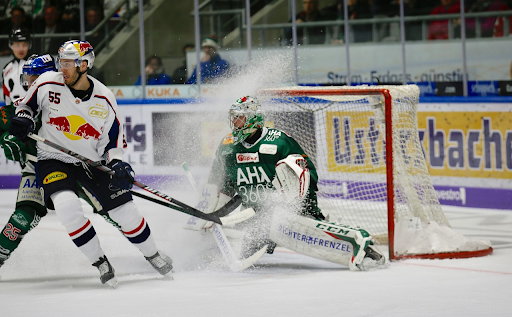As the ice hockey season unfolds, players at all levels seek ways to elevate their game and stand out. Whether you’re a seasoned veteran aiming to refine your skills or a newcomer eager to make your mark, enhancing your performance is a multifaceted endeavor beyond physical training. It’s about harnessing the right combination of technique, strategy, and mental preparedness to unlock your full potential. In this blog post, we’ll explore actionable strategies and innovative approaches ice hockey players can adopt to improve their performance this year. From fine-tuning skating techniques and improving puck control to mastering strategic plays and boosting toughness, we’ll delve into how players can achieve their performance goals and contribute more effectively to their teams.
8 Ways Ice Hockey Players Can Enhance Their Performance This Year
Incorporate plyometric exercises into training routines
Ice hockey players can significantly enhance their performance this season by incorporating plyometric exercises into their training routines. Plyometric training, known for its dynamic and explosive movements, is perfectly suited to the fast-paced nature of ice hockey. These exercises help players develop powerful, quick movements essential for effective skating, sudden starts, stops, and direction changes on the ice.
Players can improve their explosive power by integrating plyometrics, a critical component for outmaneuvering opponents and reaching the puck faster. This type of training complements the sport’s physical demands and equips players with the agility and speed necessary to elevate their game to new heights.
Practice precision puck handling drills
Ice hockey players aiming to elevate their performance this season can significantly improve by practicing precision puck handling drills. These drills are designed to refine a player’s control and finesse with the puck, enabling them to maneuver through tight spaces and maintain possession under pressure.
By focusing on precision, players can enhance their ability to execute accurate passes, maintain control during rapid gameplay, and improve their stickhandling skills. This meticulous approach to training helps develop a player’s confidence on the ice, ensuring they are prepared to face any challenge with the puck at their stick. Regular, focused puck-handling drills allow players to become more versatile and unpredictable, making them invaluable assets to their teams.
Focus on agility and speed training
Ice hockey players can significantly boost their performance by focusing on agility and speed training. This aspect of physical preparation is crucial in a sport where quick reflexes and the ability to change direction rapidly can make a substantial difference in gameplay.
Agility training enhances a player’s ability to execute sharp turns, evade opponents, and adjust positioning swiftly, while speed training improves overall pace on the ice, allowing players to outrun competitors and react faster to unfolding plays. By dedicating time to drills and exercises designed to increase agility and speed, players can gain a competitive edge, making them more effective in offensive and defensive situations.
Analyze and improve shot accuracy
Ice hockey players can enhance their performance by analyzing and improving their shot accuracy. Precision in shooting is a critical skill that can turn the tide of any game, allowing players to capitalize on scoring opportunities and increase their goal tally.
By reviewing and refining their shooting techniques, players can identify specific areas for improvement, such as wrist flicks, stick positioning, and body alignment, which are all crucial for accurately directing the puck.
Incorporating targeted drills that simulate game scenarios can also help improve shot accuracy under pressure. This systematic approach to refining shooting skills boosts a player’s confidence and makes them a formidable threat to opponents, ensuring that they can make the most of every opportunity to score.
Engage in regular video analysis of games
Ice hockey players can take their performance to new heights this season by engaging in regular video analysis of games. This technique allows players and coaches to dissect gameplay, pinpointing strengths to build upon and weaknesses to address. By meticulously reviewing game footage, players can gain insights into their positioning, decision-making, and execution under various game conditions.
This analytical approach facilitates a deeper understanding of individual and team dynamics, enabling players to identify patterns, anticipate opponents’ moves, and refine strategies. Moreover, video analysis offers the unique advantage of visual learning, where players can see their actions from a different perspective, fostering a more nuanced appreciation of the game’s tactical aspects.
Develop stronger on-ice communication skills
This season, ice hockey players can significantly enhance their performance by developing stronger on-ice communication skills. Effective communication is pivotal in a high-speed, team-oriented sport like ice hockey, where split-second decisions can determine the outcome of a game. By cultivating verbal and non-verbal cues, players can better coordinate with teammates, execute strategic plays more smoothly, and anticipate each other’s moves.
Strong communication skills enable players to convey their intentions quickly and clearly, leading to more cohesive team dynamics and a more synchronized approach to offensive and defensive strategies. This improves the overall flow of the game and minimizes errors caused by misinterpretations or lack of awareness. Teams that excel in on-ice communication often find themselves ahead of their opponents, capitalizing on opportunities and defending more effectively.
Enhance endurance through interval training
Ice hockey players can significantly boost their performance this season by enhancing endurance through interval training. This type of training involves short bursts of high-intensity effort followed by periods of rest or lower intensity, closely mimicking the stop-and-go nature of ice hockey. You can also try prerolls from https://trehouse.com/collections/prerolls/ for better endurance.
By adapting their bodies to recover quickly between these bursts, players can maintain a high level of play throughout each period. This improved endurance is crucial for late-game situations when fatigue sets in, allowing players to continue executing plays effectively and precisely.
Additionally, the improved aerobic and anaerobic capacity gained from interval training can give players an edge over their opponents, enabling them to skate faster, engage more aggressively in puck battles, and reduce the time needed for recovery during breaks and between shifts.
Implement mental visualization techniques
Ice hockey players can significantly enhance their performance this season by implementing mental visualization techniques. This psychological strategy involves players mentally rehearsing their movements, plays, and game scenarios, envisioning success and positive outcomes in their minds.
By regularly practicing mental visualization, players can improve their focus, reduce game-day anxiety, and boost their confidence on the ice. This technique allows them to mentally prepare for various situations they may encounter during a game, enabling quicker, more intuitive responses when those moments arise.






